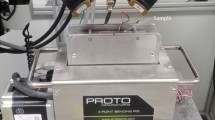Abstract
An experimental method of the principal stresses estimation which is based on photoelasticity and isopachic methods is presented. The principal stresses at the bi-material interface crack-tip are theoretically determined using the combination photoelastic and isopachic fringes. The size and the shape of crack-tip isochromatic and isopachic fringes, at a bi-material interface under static load, are studied. When the crack-tip, which is perpendicular to interface, is placed at the interface of the bi-material, the isochromatic and the isopachic fringes depend on the properties of the two materials. Thus, the isochromatic and the isopachic fringes are divided into two branches, which present a jump of values at the interface. The size of the two branches mainly depends on the elastic modulus and the Poisson’ s ratio of the two materials. From the combination of the isochromatic and the isopachic fringes, the principal stresses σ1 and σ2 can be estimated and the contour curves around the crack-tip can be plotted.
Similar content being viewed by others
References
Dally J.W., kobayashi T. (1978).Crack arrest in duplex specimens. International Journal of Solids and Structures 14, 121-126
Frocht M.M. (1948). Photoelasticity. John Willey, New York
Papadopoulos G.A. (1993). Fracture Mechanics. The Experimental Method of Caustics and the Det.-Criterion of Fracture. Springer-Verlag, London Lim
Papadopoulos G.A. (1999). Crack-tip caustics at a bi-material interface. International journal of Fracture 98, 329-342
Papadopoulos G.A., Moscos N. (2006). Crack-tip isochromatic and isopachic fringes at a bi-material interface. International journal of Fracture 141, 327-332
Williams, M.L. (1952a). Surface stress singularities resulting from various boundary conditions in angular corners of plates under bending. Proceedings, First U.S. Nat. Congress of Applied Mechanics, ASME, 325-329.
Williams M.L. (1952b). Stress singularities resulting from various boundary conditions in angular corners of plates in extension. Journal of Applied Mechanics 19 Trans. ASME 74, 526-528
Williams M.L. (1957). On the stress at the base of a stationary crack. Journal of Applied Mechanics 24, Trans ASME 79: 109-114
Williams M.L. (1959). The stresses around a fault or crack in dissimilar media. Bulletin of the Seismological Society of America 49, 199-204
Zak A.R., Williams M.L. (1963). Crack point stress singularities at a bimaterial interface. Journal of Applied Mechanics 30, 142-143
Author information
Authors and Affiliations
Corresponding author
Rights and permissions
About this article
Cite this article
Papadopoulos, G.A., Kravaritis, J. & Badalouka, B. Crack-Tip Principal Stresses by Isochromatic and Isopachic Fringes at a Bi-material Interface. Int J Fract 148, 73–78 (2007). https://doi.org/10.1007/s10704-008-9180-z
Published:
Issue Date:
DOI: https://doi.org/10.1007/s10704-008-9180-z




